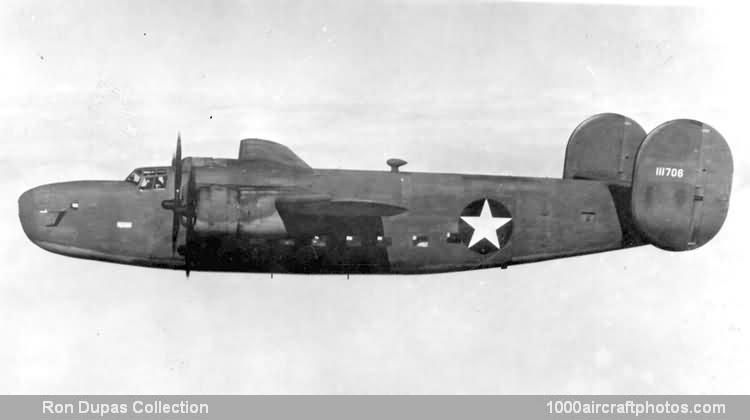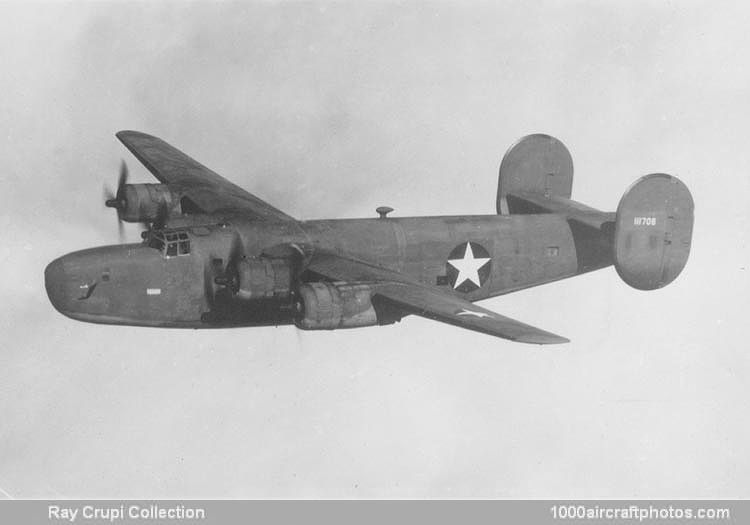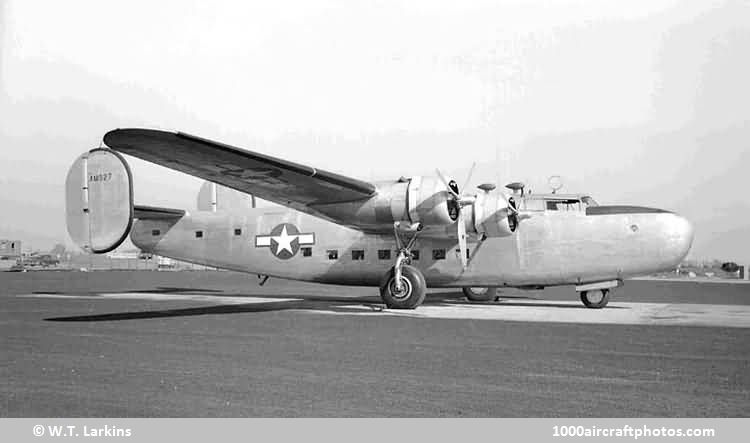04/30/2015. Remarks by
Johan Visschedijk: "The first six
LB-30A Liberators delivered to the RAF were used as transports in the North Atlantic Return Ferry Service (NARFS); transatlantic flights began on May 4, 1941. Subsequently a specific version was created for this task. Designated C-87 and known as the Liberator Express, this had a modified fuselage with 25 seats, windows, and a port side loading door. A prototype was completed at San Diego from a crashed B-24D in 1942 and conversions were made on the production line at Fort Worth, Texas, with the XC-87 making its first flight on August 24, 1942, followed by 279 more by August 1944. Five were transferred to the Navy as RY-2s.
(
Ray Crupi Collection)
Six VIP sixteen-passenger/ten-berth C-87As were also built, three each for the USAAF and USN (the latter known as RY-1s). One of the USAAF aircraft became the presidential "Guess Where II". Some C-87s operating over the 'Hump' had two fixed forward-firing guns but the C-87B, with five 0.50 in (12.7 mm) guns, was not built. Five C-87s were completed as flight engineer trainers, designated AT-22 and later TB-24Ds. They carried a crew of five plus thirteen instructors and pupils. Another twelve B-24s were converted to C-87 standard, including one by Ford which differed in details and was called the Ford Utility Transport. During the latter stages of the war, several B-24s were converted as transports and designated CB-24s. The RAF used 24 Liberator Mk.VIIs (C-87s) on Far East routes, while the RAAF operated two C-87s.
Ford converted a B-24E to the XC-109 in 1943 with an extra 2,036 gal (7,707 l) of fuel in eight light alloy tanks for use in the China-Burma-India theatre to ferry gasoline to China-based B-29 units. Ford converted another 199 and Martin nine C-109s from B-24J and B-24L models with flexible instead of metal tanks, an automatic APU shut-off, and a modified fuel systems. After several take off crashes, the fuselage fuel load was frequently reduced to 1,200 gal (4,544 l). Limited use was made of the C-109 in Europe in 1944.
Quasi-civil Liberator flights began on September 24, 1941, when BOAC started operating the NARFS. A UK - Cairo service opened on January 25, 1942, and this was followed by regular Moscow service via North Africa, Iran, and Astrakhan. Five Liberator C.IIIs were also used for Lisbon and West Africa routes. The NARFS was demilitarised in September 1946, and seven Liberators were converted to all-cargo configuration and operated on the same route until April 1949, when the service was taken over by Scottish Aviation. One, operated by BOAC, was used for day and night in-flight refueling experiments over the North Atlantic with Avro Lancastrians. Five were sold to STA Alpes Maritimes in West Africa and one was converted at Marseilles into a VIP aircraft for Emperor Bao Dai of Vietnam.
Four Liberator C.IIIs were passed to QANTAS and these opened a Learmouth (Perth) - Ratmalana (Ceylon) seventeen-hour service on June 17, 1944. Sydney became the terminal of the Indian Ocean route on November 30, 1945. A Sydney-Singapore service started on April 7, 1946, and the last of 259 Indian ocean crossings was made on August 31. Two aircraft were used by QANTAS as freighters until 1950. Scottish Aviation converted five Liberators to 30-passenger transports in 1946 for scheduled services between Reykjavik and Prestwick and Northolt (for Flugfelag Islands) and Northolt and Athens (for Hellenic Airlines). The Scottish fleet was also active on the Berlin Airlift but all were withdrawn in September, 1949.
Passenger-carrying B-24s were also used in Chile and Mexico in the 1950s, and six were registered in Bolivia, mostly for the carriage of meat.
Consolidated 32 LB-30A Liberator B.Mk.I (AM927) (
W.T. Larkins Memorial Collection)
In the United States, a few were converted as executive transports, including the LB-30 AM927 used by Convair to link its New York office with San Diego and Fort Worth. For eleven years this aircraft flew with the Continental Can Co. and after another eight years of executive use by Pemex in Mexico, in 1967 it was acquired by the Confederate Air Force and registered
N24927. This is the sole complete LB-30 in existence. Fourteen complete B-24s remain also preserved today, eight of them in the USA."



